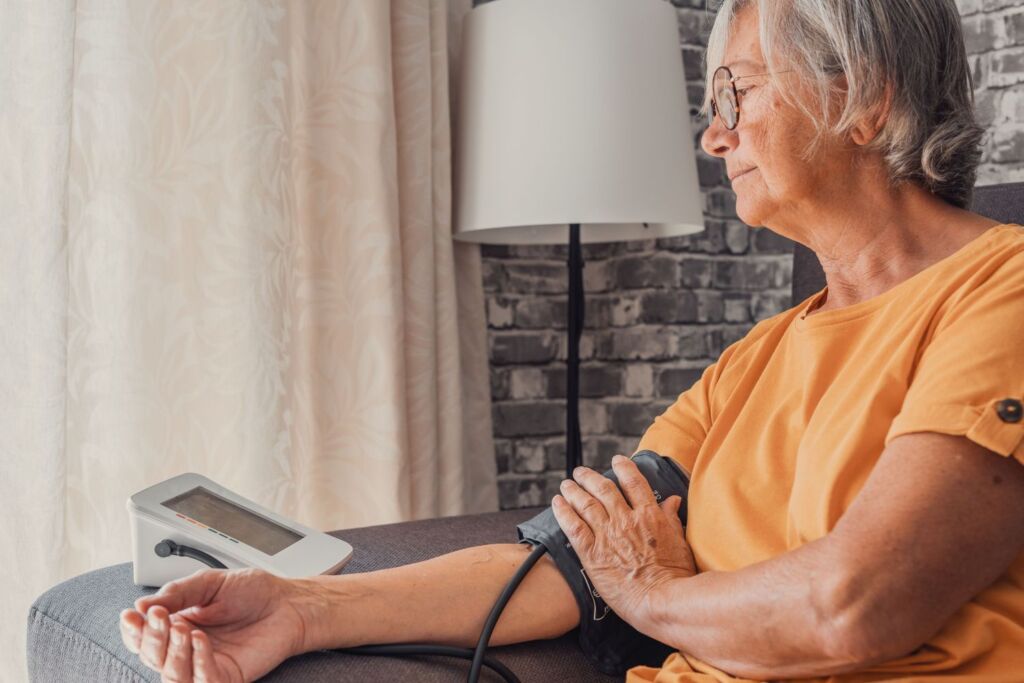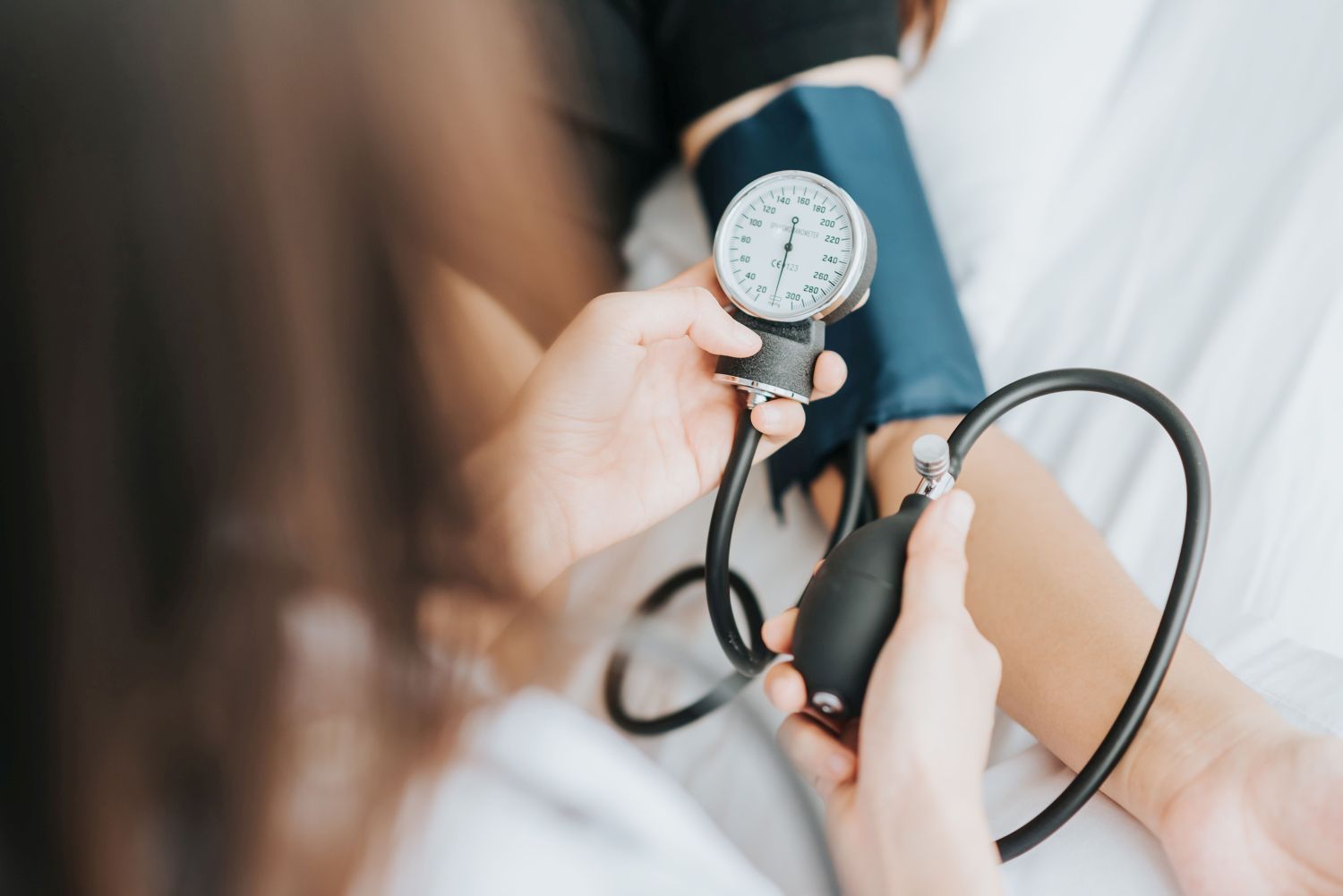Blood pressure definition
In order for the blood to flow through the blood vessels to the organs and tissues and supply organs and tissues with oxygen and nutrients, it must be under pressure. Two mechanisms ensure that this pressure is maintained: the pumping of the heart and the elasticity of the vascular walls. When the heart muscle contracts and pumps the blood forward, a higher blood pressure is created in the arteries (upper systolic pressure). When the heart subsequently relaxes and refills itself with blood, the blood pressure in the arteries falls (lower diastolic pressure).
Blood pressure is regulated by complex mechanisms: these include the contraction and relaxation of the heart and blood vessels, the regulation of blood volume by the kidneys as well as hormonal and neurological mechanisms.
Blood pressure values and health
Adequate blood pressure is crucial for maintaining a healthy cardiovascular system. Blood pressure values that regularly exceed the norm can increase the risk of heart attack, heart failure, stroke or kidney disease. If blood pressure is too high, it is called hypertension, and if it is too low, it is called hypotension.
As high blood pressure does not usually cause any symptoms, it is important to monitor blood pressure. Complications can be avoided by measuring blood pressure regularly and treating changes in blood pressure at an early stage.
Measure blood pressure
There are various methods for measuring blood pressure. The direct method, also known as the invasive method, is used in clinical settings such as intensive care and operating theaters. This usually involves puncturing a peripheral artery and connecting a catheter to a pressure sensor. The indirect method, also known as the non-invasive method, uses an electronic blood pressure monitor or auscultatory measurement with a stethoscope.
Errors can often occur when measuring blood pressure. These errors affect the accuracy of the measurement and lead to incorrect results. Some of the most common mistakes when measuring blood pressure:
- Insufficient rest time before the measurement or measurement during the complaint
- Measurement after coffee/tea or similar substances or after tobacco/nicotine consumption
- Use of an incorrect cuff size
- Measurement on an artery that is not at heart level (often with wrist blood pressure monitors)
It is important to avoid these errors in order to obtain accurate measurement results and enable an appropriate medical assessment.

Tips for accurate blood pressure measurements and for self-measurement at home
To ensure accurate blood pressure measurements, follow these tips:
- Rest for at least 5 minutes before the measurement and avoid physical exertion, coffee/tea or similar substances as well as tobacco/nicotine consumption.
- Make sure you are in a comfortable position with your back supported and your arms relaxed.
- Place the cuff at heart level and make sure that it is tight but not too tight.
- Breathe calmly and evenly during the measurement.
- Take at least 2 measurements a few minutes apart and calculate the average.
- Keep a measurement log with date, time and values.
- Consult your doctor regularly and discuss the results.
Diastolic and systolic blood pressure
A distinction is made between two values when measuring blood pressure: Systolic blood pressure measures the pressure during the heartbeat, when the heart muscle contracts and pumps oxygen-rich blood into the blood vessels. Diastolic blood pressure measures the pressure on the blood vessels when the heart muscle is relaxed. If one or both values are above normal for a longer period of time, the risk of cardiovascular disease is increased.
Blood pressure values: Blood pressure table
According to the guidelines of the Swiss Society for Hypertension, the following values apply for adults over 18 years of age:
|
Systolic value |
Diastolic value |
| Optimal blood pressure |
below 120 mmHg |
below 80 mmHg |
| Normal blood pressure |
120 to 129 mmHg |
80 to 84 mmHg |
| High normal blood pressure |
130 to 138 mmHg |
85 to 89 mmHg |
| Mild high blood pressure |
140 to 159 mmHg |
90 to 99 mmHg |
| Moderate high blood pressure |
160 to 179 mmHg |
100 to 109 mmHg |
| Severe high blood pressure |
from 180 mmHg |
from 110 mmHg |
It is completely normal for blood pressure to sometimes be higher and sometimes lower during the course of the day. Physical exertion after sport or stress and pain can increase blood pressure. Temperature differences or particulate matter pollution also influence blood pressure values
Normal blood pressure: difference in women/men
The medical guidelines for blood pressure limits apply equally to adult women and men of all ages. The values in the above blood pressure table are therefore valid for both sexes. However, the recommended therapeutic goal for drug treatment may vary depending on the patient’s age and concomitant diseases.
High blood pressure and low blood pressure
High blood pressure, also known as hypertension, and low blood pressure, also known as hypotension, are important health indicators that can affect well-being and quality of life.
- High blood pressure (hypertension): This condition, characterized by elevated blood pressure in the arteries, is a known risk factor for heart disease, stroke and kidney disease. Regular monitoring and appropriate treatment are crucial to minimize the risks and maintain health.
- Low blood pressure (hypotension): Low blood pressure refers to abnormally low pressure in the arteries. Some people live with constantly low blood pressure without feeling it. Nevertheless, low blood pressure can cause symptoms such as dizziness, tiredness or fainting spells. Orthostatic hypotension is a special form in which the blood pressure drops sharply when you stand up, which can lead to dizziness or blackness before the eyes. Low blood pressure is diagnosed by typical symptoms and blood pressure measurements. Orthostatic hypotension is recognized by measurements taken while lying/sitting and immediately after standing up.
Blood pressure prevention and management
By implementing these preventative measures and maintaining a healthy lifestyle, you can minimize the risk of blood pressure problems and improve your overall health and quality of life. Some tips for prevention:
- Healthy diet: Reduce your consumption of salty, fatty and sugary foods. Instead, focus on a balanced diet rich in fruit, vegetables, wholegrain products and lean protein.
- Regular physical activity: Do regular sport and physical activity to strengthen your cardiovascular system and control your weight. This includes aerobic exercises, strength training and flexibility exercises.
- Weight management: Maintain a healthy weight, as obesity is a risk factor for high blood pressure. You can control or reduce your weight through a combination of a healthy diet and physical activity.
- Alcohol and tobacco/nicotine consumption: Limit alcohol consumption and avoid smoking, as these factors can increase the risk of high blood pressure.
- Stress management: Find ways to reduce and manage stress, be it through relaxation techniques such as meditation, yoga or regular breaks in everyday life.
Early detection of high blood pressure is also important. Regular medical examinations and blood pressure measurements can help to identify potential problems at an early stage and take appropriate measures.

